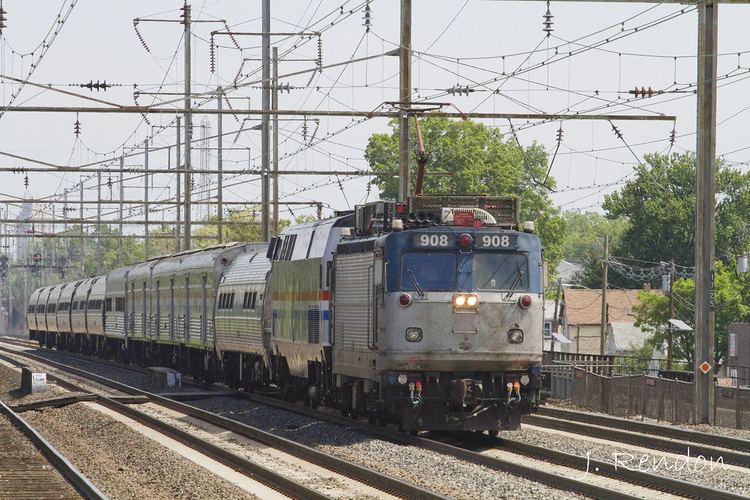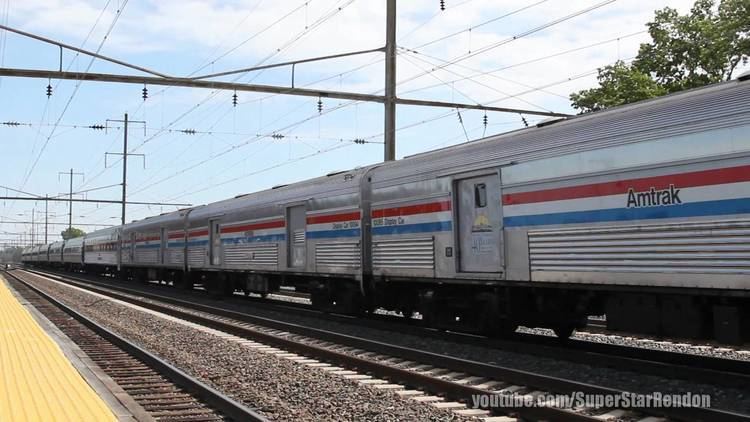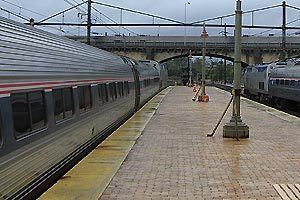Status Operating Stops 17 | Distance travelled 444 miles (715 km) First service 27 April 1980 | |
 | ||
Ridership 568 daily207,422 total (FY11) Average journey time 9 hours, 15 minutes (westbound), 9 hours, 20 minutes (eastbound) Track owners | ||
The Pennsylvanian is a 444-mile (715 km) daytime Amtrak train running between New York and Pittsburgh via Philadelphia. The trains travel across the Appalachian Mountains, through Pennsylvania's capital Harrisburg, the Pennsylvania Dutch Country, suburban and central Philadelphia, and New Jersey en route to New York. Trains run once daily in each direction and utilize Amfleet equipment. The entire train ride takes about 9 hours total, with 1.5 hours between New York and Philadelphia, 2 hours between Philadelphia and Harrisburg, and 5.5 hours between Harrisburg and Pittsburgh.
Contents

The Pennsylvanian is a once a day replacement of the Keystone service between New York and Harrisburg, offering Business Class seating as an upgrade to the coach-only seating on Keystone trains. Prior to Amtrak, the route was known as the Duquesne, named after Fort Duquesne in Pittsburgh, and operated by the Pennsylvania Railroad. The Pennsylvanian began on April 27, 1980, as a state-supported daylight train between Philadelphia and Pittsburgh, with connecting service to New York. The train was extended to New York in 1983. Between November 1998 and January 2003, Amtrak shifted the endpoints west to Chicago and Philadelphia, providing daylight service to Cleveland, Ohio. In 2003 the Pennsylvanian reverted to the Pittsburgh—New York schedule.

History

The Pennsylvanian is the replacement of the former Keystone service between New York and Pittsburgh. Prior to Amtrak, the route was known as the Duquesne, named after Fort Duquesne in Pittsburgh, and operated by the Pennsylvania Railroad. The Duquesne had a long history, finally becoming a daily New York—Pittsburgh train on October 25, 1959, numbered 16 eastbound and 25 westbound. With the start of Amtrak operations on May 1, 1971, the Duquesne was renamed the Keystone and renumbered 42 westbound and 43 eastbound with the first Amtrak timetable on November 14, 1971. The Keystone was discontinued on April 30, 1972.

The immediate impetus for the Pennsylvanian was the discontinuance of the National Limited, a New York–Kansas City train which had provided service over the corridor. The Pennsylvanian began on April 27, 1980, as a state-supported daylight train between Philadelphia and Pittsburgh, with connecting service to New York via the Philadelphian (a Clocker) westbound and the Montrealer eastbound. At the time the Pennsylvanian was inaugurated, the Broadway Limited was departing Pittsburgh at an inconvenient early morning hour. The new train ran with Amfleet equipment, including a cafe car. Pennsylvania agreed to pay 20% of the train's costs for the first year, or $580,000, with the state and Amtrak eventually splitting the costs 50/50 by the third year.

Between 1981 and 1983, Pennsylvanian equipment was turned every night to operate a second state-supported train, the Fort Pitt, which ran from Pittsburgh to Altoona. Amtrak withdrew this train in early 1983 after the Pennsylvania Department of Transportation (PennDOT) declined to continue subsidizing the increased operation. At the time the Fort Pitt carried 30 passengers per day. On October 30, 1983, the Pennsylvanian was extended to New York City, eliminating the transfer at Philadelphia.

After significant ridership gains in 1984, PennDOT proposed that a second train be added to the route. PennDOT and Amtrak would have split the costs evenly. Amtrak officials were favorable, but budget problems stalled the plan.
In the late 1980s passenger-rail groups urged Amtrak to extend the Pennsylvanian to Cleveland, Ohio. Proposals included new stations in Sewickley and Beaver Falls. Pressure increased in 1989 when Amtrak announced the re-routing of the Broadway Limited and Capitol Limited over that same route as part of a restructuring of routes in Indiana. As part of this change, the Capitol Limited began serving the Cleveland—Pittsburgh route, albeit in the middle of the night. Amtrak and PennDOT considered two routes for an extended Pennsylvanian: one via Alliance, Ohio (following the route of the Capitol Limited) and one via Youngstown, Ohio (partially following the Broadway Limited) with a new stop in New Castle, Pennsylvania.
On November 7, 1998, Amtrak extended the Pennsylvanian through to Chicago along the route of the Capitol Limited via Toledo, finally bringing a daylight connection to Cleveland. The Three Rivers continued to run over a different schedule via Akron and Fostoria. As part of the change Amtrak truncated the eastern end to Philadelphia, enabling the train to complete the run within a single day. The change was driven by Amtrak's growing mail and express business; Pittsburgh–Philadelphia ridership suffered. Amtrak returned the Pennsylvanian to the New York—Pittsburgh route on January 27, 2003, citing low ridership and Amtrak's withdrawal from the express freight business. On November 1, 2004, Amtrak merged the Pennsylvanian and Three Rivers, keeping the latter name with a western terminus in Chicago. Amtrak had sought $2.5 million in assistance from Pennsylvania to keep both trains running. On March 8, 2005, Amtrak truncated service to Pittsburgh—New York and restored the Pennsylvanian name to the route.
As of 2010 there is no through service west of Pittsburgh; the Capitol Limited continues to provide service to Chicago, though as part of its federally mandated analysis of the worst-performing long-distance routes, Amtrak determined that reinstating a through-car connection with the Pennsylvanian would result in the highest gain in monetary and customer service measurements of possible options. To implement this, Amtrak plans to operate a Viewliner sleeper car, an Amfleet cafe car and two Amfleet coaches between Chicago and New York approximating the historic Broadway Limited, via the Capitol Limited and Pennsylvanian. This would begin when funding and equipment is available.
On January 28, 2011, it was announced that Pennsylvania had received a $750,000 grant from the federal government to study expanding service westwards from Harrisburg to Pittsburgh along the route of the Pennsylvanian, including higher speeds and additional frequencies.
During fiscal year 2011, the Pennsylvanian carried over 200,000 passengers, a 2% increase over FY2010. The train had a total revenue of $8,856,539 during FY2011, up 4.8% from FY2010. In Fiscal Years 2012 and 2013, ridership increased to 212,006 and 218,997 respectively. Likewise, revenue increased to $9.28 and $10.4 million respectively. In May 2013 the Commonwealth of Pennsylvania agreed to $3.8 million in funding to subsidize the service.
In November 2013, The Pennsylvania Department of Transportation announced that funding would be provided for the train to operate until October 1, 2014. The change in subsidy resulted from the 2008 Passenger Rail Investment and Improvement Act, which eliminated federal subsidies for Amtrak routes less than 750 miles in length
Equipment
On its inauguration the Pennsylvanian ran with then-new Amfleet equipment: two coaches and a cafe. Today the Pennsylvanian continues to use an all-Amfleet consist although the number of coaches has grown to six. The train consists of an Amfleet I business class car, an Amfleet I cafe car, an Amfleet I coach, and three Amfleet II long-distance coach cars. Motive power is usually a Genesis diesel-electric locomotive west of Philadelphia. East of Philadelphia, the motive power is a Siemens ACS-64 electric locomotive; an engine swap is made at 30th Street Station in Philadelphia.
Route
The Pennsylvanian follows the Pennsylvania Railroad's Main Line over the following trackage:
